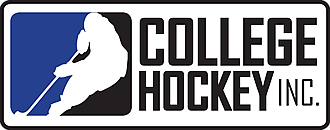Key Differences in NCAA and NHL Rules
NCAA hockey follows a rulebook that closely resembles the NHL, but with several key differences. An outline of the most significant differences is included below.
NCAA Rulebook (.pdf)
Overtimes and tie games. Regular-season overtimes are five minutes, sudden death, played 3-on-3 (unless penalties carry over from regulation or are called during overtime). Teams switch ends for overtime (guarding the same net as they did in the second period).
NCAA games can end in ties, although conferences may elect to use a three-person shootout to award points in league standings after the initial five-minute OT. Non-conference games tied after the initial five-minute OT will end as ties.
Regular-season tournaments may use a shootout to break ties after the initial five-minute OT.
Each team receives an additional timeout in overtime if it had already utilized its timeout in regulation.
Goal scored during delayed penalty. If a team scores a goal during a delayed penalty call, that call is still enforced and the penalty served. The ensuing faceoff takes place at center ice.
Contact to the head. Any time a player makes direct contact with the head or neck of an opponent it is a major penalty and game misconduct at a minimum. The responsibility lies with the player making the hit to avoid contact with the head and neck area of an opposing player. A player delivering a check to an unsuspecting and vulnerable player puts themselves in jeopardy of being penalized under this rule.
When the initial force of the contact is a shoulder to the body of the opponent and then slides up to the head or neck area, this is not classified as contact to the head. This type of action may still be penalized, at the referee’s discretion, as another penalty (e.g., charging, roughing, elbowing, etc.).
No trapezoid. There are no restrictions on where a goaltender can handle the puck behind his goal line.
Rink size and benches. The NCAA rule book calls for rink dimensions of 200’ by 85’ “as nearly as possible,” but many NCAA rinks vary. Team benches in NCAA arenas may be on opposite sides of the ice.
Puck shot directly out of play in defensive zone. There is no automatic penalty for clearing the puck over the glass in the defensive zone, although a delay of game penalty can be called at the discretion of the officials if the action was deemed to be intentional.
Hand passes in the defensive zone. Hand passes are not allowed in the defensive zone in NCAA play, with those situations whistled down as they would be elsewhere on the ice. When the infraction takes place in the defensive zone the offending team will not be able to change players prior to the ensuing faceoff.
Fighting. Fighting is penalized with a five-minute major and a game disqualification, meaning that the offending player is out of that game and the next game.
Face shield. All players are required to wear an approved face mask or shield.
Sticks. NCAA rules allow all players to use sticks up to 65 inches in length (NHL rules require players to seek a waiver for use of sticks between 63 and 65 inches). A goaltender’s paddle may be up to 28 inches long.
Goaltender equipment. The NCAA rules committee intends to follow, as quickly as is feasible, all NHL goaltender equipment specifications.
Penalty Shots. When any infraction of the rules calls for a penalty shot not involving a major, disqualification or misconduct penalty, the non-offending team shall be given the option of accepting the penalty shot or having a minor penalty assessed to the offending player.
Faceoffs. In faceoffs in an offensive zone, the defending team will put their stick down first for the faceoff. In all neutral-zone faceoffs, the visiting team puts their stick down first. A linesman shall conduct all faceoffs.
On an initial faceoff violation, the center shall not be removed. The linesman will issue a warning to the violating team and any subsequent violation by the same team during the same faceoff will result in a bench minor.
Video replay. During the season, at a conference’s discretion, video replay may be used by the on-ice officials using a monitor at the scorers’ table. All goals are reviewed initially by a replay official. Should a situation occur that the replay official believes requires a review (or if the on-ice referee decides to review a play), the replay official will offer information and assist in the review. The on-ice referees will review the play at the scorer’s bench and make the decision.
Video replay may be used, if available, to determine if a play that led to a goal was offsides or if the attacking team had too many men on the ice. During the regular season, prior to the final 10 minutes of regulation and overtime, these reviews require a coach’s challenge. Goals scored where a high stick or puck hitting the protective netting is in question require a coach’s challenge to be reviewed.
Once a review is initiated, all aspects of a play that are eligible for review may be considered, not just what has been challenged by a coach.
In the NCAA Tournament and in conference tournaments or regular-season games with suitable facilities, a video replay official will be assigned to a booth in the arena, much like in the NHL.
Officials may use video replay during a game to review penalties that would result in the removal of a player to ensure proper enforcement. This option, previously only available in the postseason, now applies to the regular season as well.
The use of video in the players’ bench area is prohibited.
Skaters. Teams may dress up to 19 skaters in a game.
Goaltenders. Teams may dress up to three goaltenders in a game.
